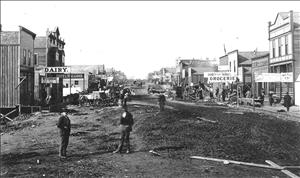On May 4, 1893, Everett is officially incorporated. In an election held in late April 1893, voters chose to incorporate and to elect Democrat Thomas Dwyer as the city's first mayor.
Cruising on Empty
The townsite of Everett began in the fall of 1891 and rapid development continued into 1893. Planned and developed by wealthy East Coast and regional investors, Everett was expected to be the location where the Great Northern Railway would first reach western tidewater, opening the way for international trade.
John D. Rockefeller (1839-1937) had substantial investments in the venture and formed the Everett Land Company to plan and operate the young town. Four major industries were expected to provide a diverse economy: There was a paper mill in Lowell; a whaleback bargeworks on the Snohomish River; a nailworks company on Port Gardner Bay; and a smelter near the bargeworks that would refine the ores expected to come from the town of Monte Cristo, located in the Cascade mountains. Lumber and shingle mills and other industries set up at waterfront locations.
A business community and residential neighborhood first began on Everett’s riverside and, in a short time, stores lined Hewitt Avenue and Pacific Avenue. Property on Port Gardner Bay was slower to be developed since the tidelands were involved in litigation, awaiting state valuation. By the summer of 1892 residents were clamoring for incorporation to help smooth the town’s rough edges caused by rapid growth. Investors awaited incorporation before gambling on capital improvements.
Incorporation Controversies
In a continuing spirit of boosterism, Everett’s newspapers solidly backed incorporation, viewing it as a necessary reassurance for business investors. But some citizens opposed the boundaries drawn for incorporation. The city’s industries were excluded, giving them tax breaks. So was the town of Lowell. In a call for support for the pending incorporation vote, the Everett Times stated: “It is therefore a matter of much importance to the future welfare of Everett that the city be incorporated” (Everett Times, April 5, 1893).
Everett was positioned for continuing growth but a national depression -- the Panic of 1893 -- soon slowed development. Everett cruised through the year mostly on hopes, dreams, and previously --invested money.
Despite the gloomy economic climate, Everett residents had reason to be hopeful. In 1893 the Great Northern Railway reached Everett; Everett’s new street rail system was in place and Puget Sound Reduction works -- the smelter -- was just being completed. Legal issues involving the tidelands were resolved in January and tidelands were purchased in February, allowing for waterfront development on Port Gardner Bay. Everett citizens hoped this momentum would shield them from the depression.
Voting to Incorporate
By 1893 Everett had an estimated population of about 5,000 people, 972 of them registered voters. A committee was formed to draw a ballot that included Republican, Democrat, and Populist candidates. An agreement was reached whereby the Democrats nominated the mayoral candidate, the Republicans picked a representative for city treasurer and three members of the council and the Populists chose a candidate for city clerk and one council member. The seventh council member and the city attorney were chosen in an open race.
The election took place on April 27, 1893. Incorporation passed 670 to 99 and the fusion ticket was overwhelmingly accepted. Administration for the first Everett city government included:
-
Mayor -- Thomas Dwyer
-
Treasurer -- James Hambly
-
City Attorney -- H. D.Cooley
-
Marshal -- Dennis Crowe
-
Health Officer -- Dr. O. V. Harris
-
Assessor -- Charles Reed
Councilmembers:
-
W.G. Swalwell
-
J. J. Maney
-
Sam Nichols
-
O. N. Murdock
-
W. J. Gillespie
-
S. E.Thayer
-
C. A. Swineford.
Weathering Hard Times
The new administration quickly began dealing with issues facing any new city and, although incorporation helped, it did not dispel the economic gloom. By mid-1894 many building projects were on hold or had died. That year the Pacific Bargeworks completed and launched the whaleback named the City of Everett, but it was to be the firm's first and last ship. John D. Rockefeller, who had invested heavily in the Everett enterprise, soon withdrew his money and, of Everett’s four pivotal boomtown industries, only the paper mill in Lowell survived.
During the next five years, many community services such as hospitals, schools, and libraries grew and solidified in response to need. The Everett Land Company was reorganized as The Everett Land Company associated with James J. Hill (1938-1916) and as the twentieth century approached, a new boom began. Between 1900 and 1910 Everett’s population grew from 8,000 to 24,000 and the city’s economy became increasingly dominated by the lumber and shingle trade.
In November 1907 Everett citizens approved a “City of the First Class” charter, upgrading from the original third-class status.

